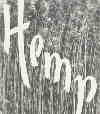
|
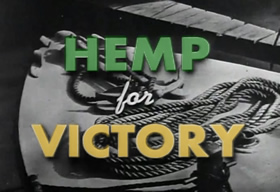 DURING THE SECOND WORLD WAR |

|
|---|
SECTION 5.2
AMERICA'S "HEMP FOR VICTORY" FARMERS:
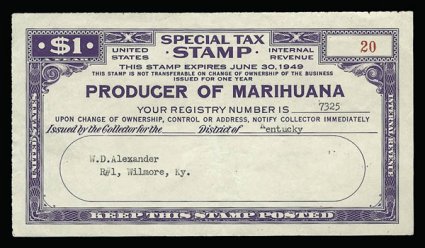
THE FARMERS
THOSE WHO GROW HEMP DURING THE WAR:
Who were America’s Industrial Hemp Farmers during the war?
To some extent we must remember that America STILL had Industrial Hemp farmers operating at the very beginning of the war. But given decades of cheap imports, not to mention the ill effects of the Reefer Madness campaign; ---Just not that many of them, but more than enough farmers were still growing hemp to form the nucleus of the Hemp-for-Victory growth.
The following document (obtained via the National Archives in College Park, Md.), show this to be the case. Note that it shows that in 1935 (just 7 years before the war) just seven Nebraska counties had over a hundred and sixty hemp farmers there.
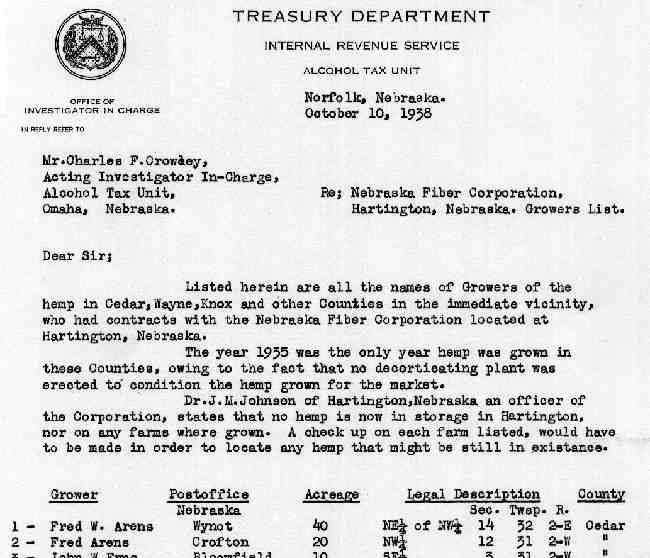
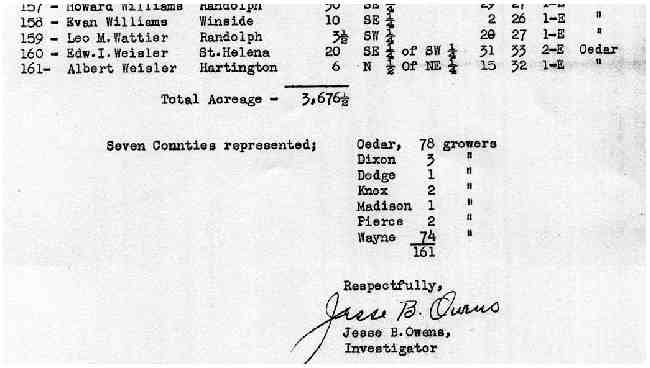
[ feel free to ask for copies of the originals ]
However, despite the above and the fact that other such documents exist for other states, it must be emphasized that after decades of cheap imports, America’s Industrial Hemp Industry (while still in existence) was at this point a mere shadow of its former self.
LOCATIONS - WHERE THE HEMP GROWN:
As all Hemp producers were required by law to register under the M.T.A. (Marihuana Tax Act), even during the war. Therefore old I.R.S. tax statistics give us some pretty clear numbers showing exactly what states they were located in during the war.
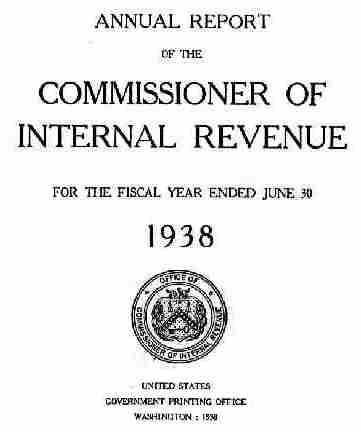
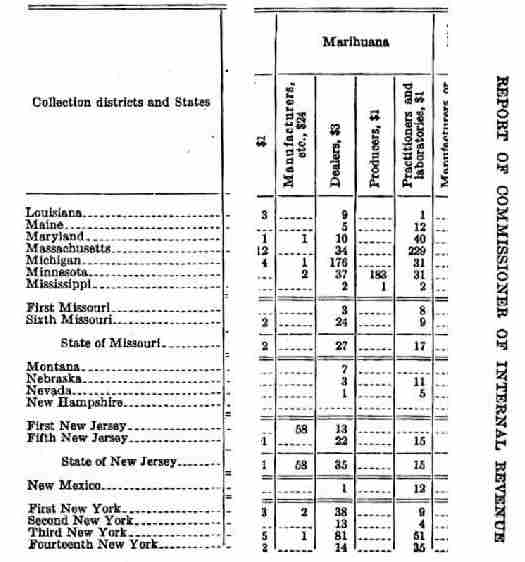
| STATE | 1938 | 1939 | 1940 | 1941 | 1942 | 1943 | 1944 | 1945 | 1946 | 1947 | 1948 | 1949 | 1950 | 1951 |
| Alabama | - | - | - | 1 | 2 | 1 | 1 | - | - | - | - | - | - | - |
| Calif. | - | - | - | - | - | - | - | - | 1 | - | - | - | 1 | - |
| Colorado | - | - | - | - | - | - | 2 | 2 | - | - | - | - | - | - |
| Delaware | - | - | - | - | - | - | - | - | - | - | - | 1 | 1 | - |
| Illinois | - | 1 | 2 | - | 1 | 3272 | 3331 | 934 | - | 1 | 1 | - | - | - |
| Indiana | - | - | 1 | 1 | - | 844 | 845 | - | - | - | - | - | - | - |
| Iowa | 2 | - | - | 2 | - | 4073 | 4083 | 986 | 1 | 1 | 1 | 1 | - | - |
| Kentucky | 154 | 36 | 108 | 321 | 8308 | 9200 | 15178 | 130 | 84 | 130 | 145 | 40 | 36 | 22 |
| Louisiana | - | - | - | 1 | 1 | 1 | 1 | 1 | - | - | - | - | - | - |
| Mass. | - | - | - | - | - | - | 2 | - | - | - | - | 3 | - | - |
| Michigan | - | - | - | - | - | - | - | - | - | - | - | 3 | - | - |
| Minnesota | 183 | - | - | - | 107 | 3619 | 3745 | 808 | 4 | 5 | - | - | - | - |
| Miss. | 1 | 1 | - | - | 2 | 1 | - | - | - | - | - | - | - | - |
| Missouri | - | - | - | 1 | 3 | - | 2 | - | - | - | - | - | - | 1 |
| Montana | - | - | 1 | 1 | - | - | - | - | - | - | - | - | - | - |
| Nebraska | - | - | - | - | - | - | - | - | 1 | 1 | 1 | 1 | 1 | 1 |
| Nevada | - | - | - | - | - | - | 1 | - | - | - | - | - | - | - |
| New York | - | - | - | 29 | - | 3 | 15 | 17 | 1 | 5 | 2 | - | - | 3 |
| N. Dakota | 2 | - | - | - | - | - | - | - | - | - | - | - | - | - |
| Ohio | - | - | - | - | 2 | 3 | - | - | - | 6 | - | - | - | - |
| S Carolina | - | - | - | - | 3 | 5 | 1 | - | - | - | - | - | - | - |
| Tennessee | - | - | - | - | 18 | 80 | 76 | - | - | - | - | - | - | 1 |
| Utah | - | - | - | - | - | - | - | - | - | 1 | - | - | - | - |
| Virginia | - | - | - | - | 2 | 1 | 1 | 1 | - | - | - | - | - | - |
| W.Virginia | - | - | - | - | - | - | - | - | - | 1 | 1 | - | - | - |
| Wisconsin | 111 | 191 | 171 | 400 | 600 | 3451 | 3676 | 1849 | 706 | 531 | 465 | 410 | 347 | 110 |
| Wyoming | - | - | - | 9 | 7 | - | - | - | - | - | - | - | - | - |
Note the mass increase in growth only took place in a few states; Indiana, Illinois, Minnesota, Wisconsin, Iowa and Kentucky. And, believe it or not, through post-war government advertisements offering to sell old surplus war factories (see section 5.3) we know the general town/county locations. To which (according to the Chicago Daily Tribune 12-09-1942p34), “About 4,000 acres of hemp growing area adjoins each plant site“
TEACHING THE FARMERS TO GROW HEMP:
As noted previously, the number of Hemp farmers jumped up dramatically up during the war years. However, while large numbers might seem like a good thing. After all, mathematically speaking, a larger number of farmers, growing hemp on more acreage should therefore equal more product, etc. The problem was that many of these farmers had little or no experience with the crop. True there was a small nucleus of old time hemp farmers still around, but truth-be-told, they were simply too few in number.
In other words, the Dept. of Agriculture was somehow going to have to teach a whole slew of (new to hemp) farmers on exactly how to grow the plant. And as the needs were so great, it was going to have to do so very quickly. --- This was done by a myriad of methods, agricultural pamphlets, via magazine articles, etc. But perhaps the best known as well (in our opinion) the best teaching tool ever put together was the Dept. of agriculture’s film “Hemp for Victory.” To quote one newspaper article:
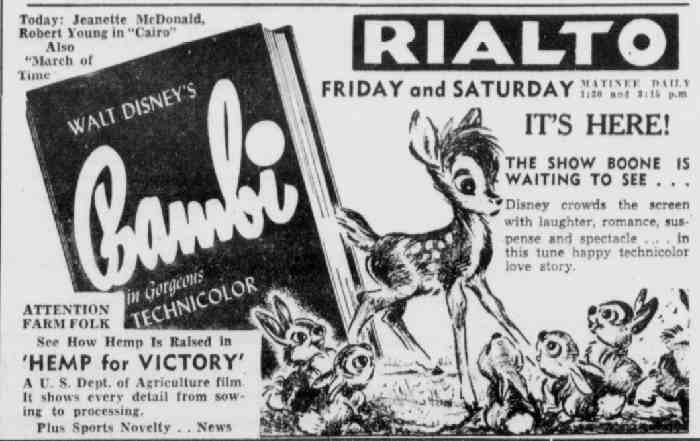
AT THE RIALTO
" A government-produced motion picture entitled “Hemp For Victory” will be shown at the Rialto on those two days, C. E. Judd, county extension director, announced this week.
“I feel this would be an excellent opportunity for those who have contracted to grow the crop to see exactly all the work involved and learn the steps from the planting to the actual use of the hemp as rope in the war,” Judd said.
’The picture runs 14 minutes, and is a most complete and comprehensive visual ‘text book’ on the subject of hemp growing. I urge every farmer planning to grow hemp to see this picture if he can do so,” Judd added.
How much seed to sow, how to put the crop in, how to determine when it is ready for harvest, how to use the different types of harvesting machinery, the turning and “retting process" which the hemp must undergo after being c u t . . . these are some of the vitally important things which will be shown in this U. S. Department of Agriculture film . . . " -- BooneNewsRepublican1943-02-02p5
MONETARY INDUCEMENTS:
HOW THE FARMERS WERE PAID:
While it would be nice to believe that farmers get up early in the day, put on white smocks, get up on their tractors and say, today, I’m going to go out and feed the world’s population. Realistically speaking, and I’m sure some noble ideas are there, for the most part (just like the rest of us), most of them are out there to make a buck. And from all accounts the pay being offered by the government to grow Hemp was more than adequate. Quoting one newspaper article:
WashingtonPost1944-10-22pM2And according to the pamphlet “HEMP - A WAR CROP FOR IOWA”:
“Farmers Find Hemp Raising Pays in Illinois”
Illinois growers realized $42.90 a ton on hemp and had a yield of 2.6 tons an acre in 1943, according to R.H. Wilcox, associated professor of agricultural economics in the University of Illinois College of Agriculture.
Cost of production and delivery was $21.19 a ton, Professor Wilcox said, which was about double the production cost of corn, but the price for hemp made it a profitable crop.
Hemp production required 19 man hours an acre, about 10 hours more than corn production. Tractor time averaged about the same, 5 1/2 hours an acre.
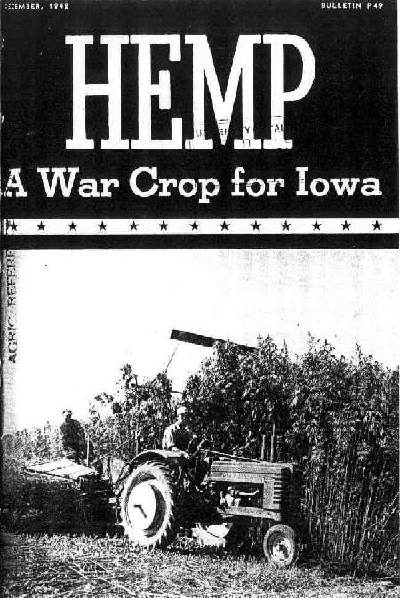
CONTRACTS FOR HEMP ACREAGE
The hemp mills in Iowa, established under the direction of the Hemp Division of the Commodity Credit Corporation, are to be financed and built by the Defense Plants Corporation, which was created to finance war industries. These mills will be operated by War Hemp Industries, Incorporated, or another duly authorized agent of the Commodity Credit Corporation. With the assistance of the State War Board, the Commodity Credit Corporation has determined sites for mill locations and growing areas. The sign-up for acreage will be made through the A.A.A.. individual contacts with farmers being made by the township A.A.A. committeemen.
Hemp growers will obtain contracts with the Commodity Credit Corporation specifying the obligations of each party in the growing, harvesting, processing and sale of the crop. Tentative contracts as of Dec. 1, 1942, include the following provisions: The grower agrees to plant a specified acreage to hemp, deliver an hemp straw produced to a designated mill, and sell such straw to Commodity Credit only. He agrees further to follow good cultural practices in growing, harvesting and handling the hemp until it is delivered to the mill, so as to deliver hemp of the highest quality possible.
Commodity Credit agrees to furnish the grower hemp seed at the rate of 114, bushels per acre contracted, at the price of $11 per bushel delivered in the county. Commodity Credit agrees also to furnish harvesters and pickers together with an operator for each machine at the price of $5, for each acre harvested. All other labor shall be furnished by the grower at his own expense, although Commodity Credit will assist insofar as is possible, in obtaining and making available at the grower's expense, additional labor for harvesting. The amount which the grower is to pay for seed and rental of machinery shall be collected only out of the proceeds of the hemp straw or fiber sold by the grower to Commodity Credit, unless there is violation of the contract on the part of the grower.
A harvesting schedule will be arranged to insure efficient and equitable use of harvesting machinery, and the grower agrees to observe this schedule. Commodity Credit agrees to purchase all hemp straw delivered to the mill by the grower at the following prices:
$50 per ton for class 1 strawGrading of straw is to be done by persons approved by Commodity Credit in accordance with classes and regulations to be established. Commodity Credit agrees to stack the hemp straw at the mill.
$40 per ton for class 2 straw
$35 per ton for class 3 straw
$30 per ton for class 4 straw
Because parts of the growing hemp plant contain a narcotic substance known as "marihuana," it is necessary for all growers and processors of hemp, and all persons handling or transporting hemp seed, to register under the Federal Marihuana Act of 1937. The Commodity Credit Corporation agrees to pay the registration tax for growers with whom contracts are made.
In other articles, it was estimated that the average price paid was $42 per ton, but that is neither here nor there. The point being made here is that with guaranteed profits, many a farmer would be all too tempted to start growing hemp. To quote one newspaper article:
“ . . . farmers who raised hemp in 1943 had made a good thing of it financially, stating that their net yield per acre had been larger than from any other crop in the nation, in some cases reaching $200” -- ChicagoDailyTribune1944-01-20p23
MONETARY INDUCEMENTS:
THE POLITICS AS USUAL OF BRINGING HOME THE BACON:
And while many of us would like to believe that all our elected officials are wonderful people, who are there solely for the public good. . . well things in real life don’t work quite that well. Simply put, someone once described a democratic election as nothing more than an auction of stolen goods, only the goods have yet to be stolen. Thus a good politician is the one who can bring home the bacon and as much of it as possible.
ChicagoDailyTribune1942-11-29p25 “Lucas Expects O.K. On Illinois Hemp Program” “Asserting that the loss of the Philippines and the Dutch Indies cut off all the supply of hemp for this country, Sen. Scott W. Lucas [D. ILL] today urged that production of the material be started in Illinois, which he said has thousands of acres available and the right climatic conditions. The senator disclosed he has made the recommendation to the department of agriculture and supplied the officials with information on the state’s facilities. Lucas said he has “every reason” To believe that land in Illinois will be used in the program the department is now planning for hemp production. “The raising of hemp,” said Sen. Lucas, “will call for the construction of numerous hemp mills. I hope that not less than 15 of these new plants will be located somewhere in the state of Illinois. The selection of the location of sites will be completely under the jurisdiction of the department, which must take into consideration soil conditions, water, transportation, labor supply, and many other factors.” ---And talk about bringing home the bacon:
“One of the beneficiaries of the hemp project in Muncle was [name withheld], an attorney and prominent figure in Democratic politics. He was the owner of the 50 acres bought by the government as a plant site. This was farmland and was selected in preference to the site of an abandoned commercial hemp factory, it was said. “ -- ChicagoDailyTribune1944-01-20p23A situation which helps explain why most of the hemp was grown in only six states. Simply put, those must have been the areas which had the most political pull at the time.
PATRIOTISM :
AMERICAN’S FARMERS DO THEIR PART:
Although, truth-be-told, America’s WW-II Hemp farmers were well compensated for growing the crop. Still one must not, cannot, believe it would be easy to just think of America’s WW-2 farmers as just so many greedy,
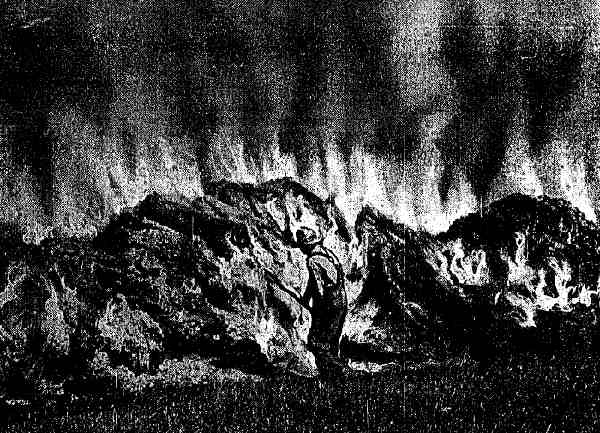
ChicagoDailyTribune1944-08-24p20
“U.S. Puts Torch to Hemp, Grown as War Product”
Losses Are Estimated at Million Dollars By Gail Compton
"Polo, Ill., Aug. 23 ---Clouds of white smoke mark thousands of dollars’ worth of government owned hemp being burned near here because it spoiled before it could be processed into fiber for making rope. Farmers who grew it in response to federal plea for hemp to help the war are embittered over the waste.
Plant employers declared today 30 per cent of the 1943 crop at Polo, which now is being converted to fiber, rotted and spoiled in the field because it was not stacked properly. They estimated 3,100 tons of hemp, for which the government paid between $30 and $50 a ton, have been lost. Stacking of the hemp was a responsibility of the pant management under contracts signed with farmers. The contracts provided the farmers were to deliver the hemp to the plant, where the management was to stack it. In some cases, it was said, this procedure was followed, and in others, because of shortage of help at the plant, the farmers themselves stacked the hemp under plant supervision. . . . . Farmers around Polo who are watching their crop go up in smoke spoke bitterly about the waste. Although they have been paid a good price for their hemp by the government they feel their patriotic efforts have been betrayed. . . , more"
The point being made here, was that if they (the farmers) were not motivated, at least to some extent by patriotism then
AFTERWARDS:
Without a doubt there will be those today who will view these workers as nothing more then a group of Marihuana workers (a.k.a. unwashed hippies). However, as we have seen from various old newspaper/magazine articles (especially given the critical times), maybe ‘Rosy the Riveter,’ style patriotism had more to do with it.
Unfortunately is seems that our country has developed a good case of selected amnesia on the whole subject. Thus, we have no oral records, no historical societies giving praise, not monuments . . . all that we have to go by are old newspaper articles and (unfortunately for us) they are most general in nature. And, grant it, there might be some old agricultural war-board records storied away somewhere in one of our national archival libraries. In all probability they will contain nothing more than simply statistics; How many pounds of finished Hemp, produced per worker, etc. Nothing that will shed any light on the subject, thus (at least for now) ‘Helen the Hemptress’ and her sisters as destined to remain unsung hero’s but hero’s never the less.
WANT TO KNOW MORE:
=====================
Due to space / download time considerations, only selected materials are displayed. If you would like to obtain more information, feel free to contact the museum. All our material is available (at cost) on CD-Rom format.
CONTACT PAGE
BACK TO SECTION IV